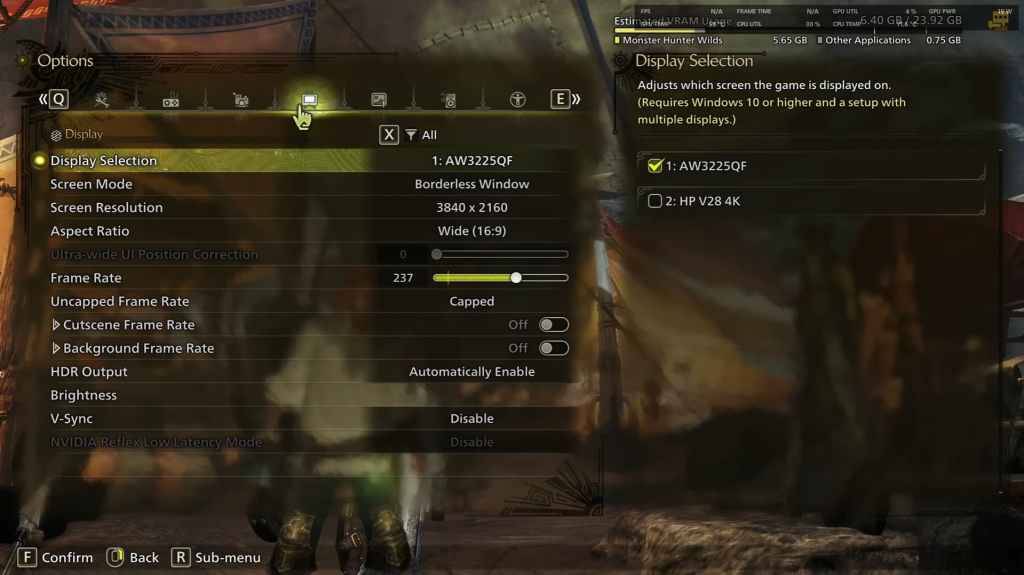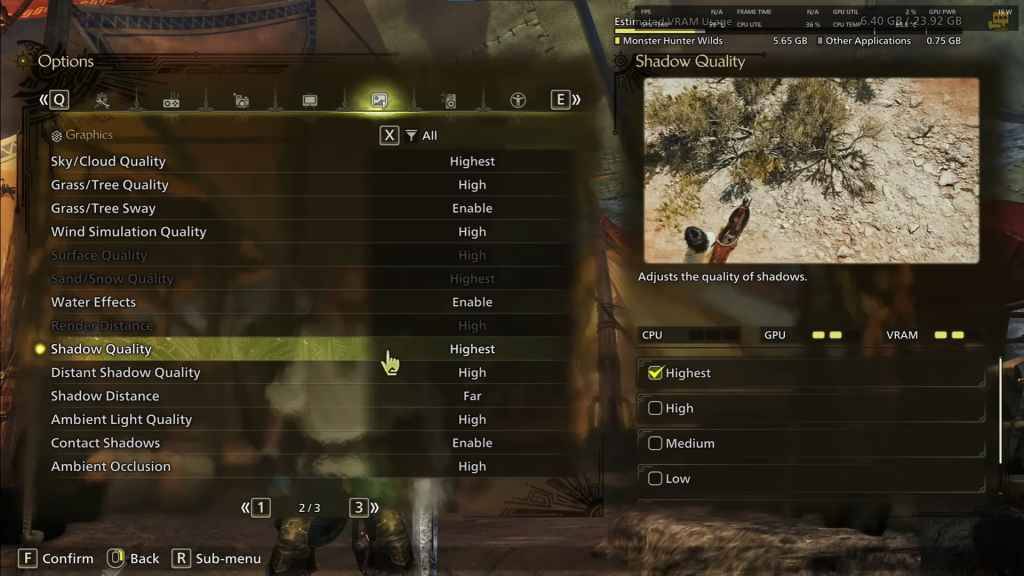Best Graphics Settings in Monster Hunter Wilds
Monster Hunter Wilds boasts stunning visuals, but achieving optimal performance while preserving visual fidelity requires careful graphics setting adjustments. This guide outlines the best settings for various PC builds.
Recommended Videos Monster Hunter Wilds System Requirements
High resolutions and maximum settings demand a high-end GPU with ample VRAM and a powerful CPU. Find out where to purchase Monster Hunter Wilds for your preferred platform.
| Minimum Requirements | Recommended Requirements |
| OS: Windows 10 or newer CPU: Intel Core i5-10600 / AMD Ryzen 5 3600 Memory: 16GB RAM GPU: NVIDIA GTX 1660 Super / AMD Radeon RX 5600 XT (6GB VRAM) DirectX: Version 12 Storage: 140GB SSD required Performance Expectation: 30 FPS @ 1080p (upscaled from 720p) | OS: Windows 10 or newer CPU: Intel Core i5-11600K / AMD Ryzen 5 3600X Memory: 16GB RAM GPU: NVIDIA RTX 2070 Super / AMD RX 6700XT (8-12GB VRAM) DirectX: Version 12 Storage: 140GB SSD required Performance Expectation: 60 FPS @ 1080p (Frame Generation enabled) |
Monster Hunter Wilds Best Graphics Settings
Optimizing Monster Hunter Wilds graphics settings is crucial, regardless of your hardware—from an RTX 4090 to a budget RX 5700XT. Significant performance gains are possible without noticeably sacrificing visual quality. The difference between Ultra and High settings is often minimal visually, but the performance impact is substantial.
Display Settings

Screen Mode: Personal preference; Bordered Fullscreen is advantageous for frequent tab switching. Resolution: Native monitor resolution. Frame Rate: Match your monitor's refresh rate (e.g., 144Hz, 240Hz). V-Sync: Off for reduced input lag.
Graphics Settings

| Setting | Recommended | Description |
| Sky/Cloud Quality | Highest | Enhances atmospheric detail. |
| Grass/Tree Quality | High | Affects vegetation detail. |
| Grass/Tree Sway | Enabled | Adds realism with a minor performance impact. |
| Wind Simulation Quality | High | Improves environmental effects. |
| Surface Quality | High | Details on the ground and objects. |
| Sand/Snow Quality | Highest | For detailed terrain textures. |
| Water Effects | Enabled | Adds reflections and realism. |
| Render Distance | High | Determines how far objects are rendered. |
| Shadow Quality | Highest | Improves lighting but is demanding. |
| Distant Shadow Quality | High | Enhances shadow detail at a distance. |
| Shadow Distance | Far | Controls how far shadows extend. |
| Ambient Light Quality | High | Enhances shadow detail at a distance. |
| Contact Shadows | Enabled | Enhances small object shadowing. |
| Ambient Occlusion | High | Improves depth in shadows. |
These settings prioritize visual fidelity over raw FPS. Since Monster Hunter Wilds isn't a competitive game, excessively compromising visuals for higher frame rates diminishes the overall experience. However, adjust these settings as needed based on your specific hardware.
To boost performance, initially reduce Shadows and Ambient Occlusion, as they are the most resource-intensive. Lowering distant shadows and shadow distance also significantly improves FPS. Finally, consider reducing Water Effects and Sand/Snow Quality, as they impact VRAM usage.
Best Settings for Different Builds
Not all systems can handle 4K. The following recommendations offer optimal settings for various hardware tiers. Settings not listed below should remain at their defaults.
Mid-Range Build (GTX 1660 Super / RX 5600 XT)
Resolution: 1080p Upscaling: AMD FSR 3.1 Balanced Frame Gen: Off Textures: Low Render Distance: Medium Shadow Quality: Medium Distant Shadow Quality: Low Grass/Tree Quality: Medium Wind Simulation: Low Ambient Occlusion: Medium Motion Blur: Off V-Sync: Off Expected Performance: ~40-50 FPS at 1080p
Recommended Build (RTX 2070 Super / RX 6700XT)
Resolution: 1080p Upscaling: FSR 3.1 Balanced Frame Gen: Enabled Textures: Medium Render Distance: Medium Shadow Quality: High Distant Shadow Quality: Low Grass/Tree Quality: High Wind Simulation: High Ambient Occlusion: Medium Motion Blur: Off V-Sync: Off Expected Performance: ~60 FPS at 1080p
High-End Build (RTX 4080 / RX 7900 XTX)
Resolution: 4K Upscaling: DLSS 3.7 Performance (NVIDIA) / FSR 3.1 (AMD) Frame Gen: Enabled Textures: High Render Distance: Highest Shadow Quality: High Distant Shadow Quality: High Grass/Tree Quality: High Wind Simulation: High Ambient Occlusion: High Motion Blur: Off V-Sync: Off Expected Performance: ~90-120 FPS at 4K (upscaled)
Monster Hunter Wilds offers extensive graphical options, but not all impact gameplay equally. For performance issues, reducing shadows, ambient occlusion, and render distance will yield the best results. Budget users should leverage FSR 3 upscaling, while high-end builds can utilize frame generation at 4K. A balanced approach involves a mix of medium-high settings, upscaling, and targeted shadow/distance adjustments based on your hardware.
Monster Hunter Wilds is available now on PlayStation, Xbox, and PC.
-
 Jan 27,25Roblox: Bike Obby Codes (January 2025) Bike Obby: Unlock Awesome Rewards with These Roblox Codes! Bike Obby, the Roblox cycling obstacle course, lets you earn in-game currency to upgrade your bike, buy boosters, and customize your ride. Mastering the various tracks requires a top-tier bike, and thankfully, these Bike Obby codes deliver
Jan 27,25Roblox: Bike Obby Codes (January 2025) Bike Obby: Unlock Awesome Rewards with These Roblox Codes! Bike Obby, the Roblox cycling obstacle course, lets you earn in-game currency to upgrade your bike, buy boosters, and customize your ride. Mastering the various tracks requires a top-tier bike, and thankfully, these Bike Obby codes deliver -
 Feb 20,25Where to Preorder the Samsung Galaxy S25 and S25 Ultra Smartphones Samsung's Galaxy S25 Series: A Deep Dive into the 2025 Lineup Samsung unveiled its highly anticipated Galaxy S25 series at this year's Unpacked event. The lineup features three models: the Galaxy S25, S25+, and S25 Ultra. Preorders are open now, with shipping commencing February 7th. Samsung's web
Feb 20,25Where to Preorder the Samsung Galaxy S25 and S25 Ultra Smartphones Samsung's Galaxy S25 Series: A Deep Dive into the 2025 Lineup Samsung unveiled its highly anticipated Galaxy S25 series at this year's Unpacked event. The lineup features three models: the Galaxy S25, S25+, and S25 Ultra. Preorders are open now, with shipping commencing February 7th. Samsung's web -
 Jul 02,22Isophyne Debuts as Original Character in Marvel Contest of Champions Kabam introduces a brand-new original character to Marvel Contest of Champions: Isophyne. This unique champion, a fresh creation from Kabam's developers, boasts a striking design reminiscent of the film Avatar, incorporating copper-toned metallic accents. Isophyne's Role in the Contest Isophyne ent
Jul 02,22Isophyne Debuts as Original Character in Marvel Contest of Champions Kabam introduces a brand-new original character to Marvel Contest of Champions: Isophyne. This unique champion, a fresh creation from Kabam's developers, boasts a striking design reminiscent of the film Avatar, incorporating copper-toned metallic accents. Isophyne's Role in the Contest Isophyne ent -
 Jan 11,25Jujutsu Kaisen Phantom Parade: Tier List Revealed This Jujutsu Kaisen Phantom Parade tier list helps free-to-play players prioritize character acquisition. Note that this ranking is subject to change with game updates. Tier List: Tier Characters S Satoru Gojo (The Strongest), Nobara Kugisaki (Girl of Steel), Yuta Okkotsu (Lend Me Your Stren
Jan 11,25Jujutsu Kaisen Phantom Parade: Tier List Revealed This Jujutsu Kaisen Phantom Parade tier list helps free-to-play players prioritize character acquisition. Note that this ranking is subject to change with game updates. Tier List: Tier Characters S Satoru Gojo (The Strongest), Nobara Kugisaki (Girl of Steel), Yuta Okkotsu (Lend Me Your Stren
